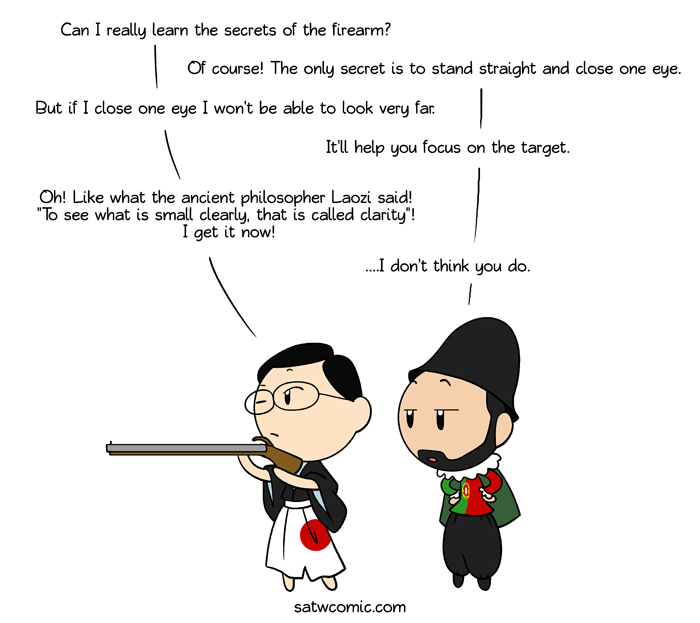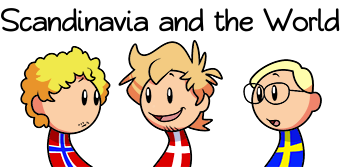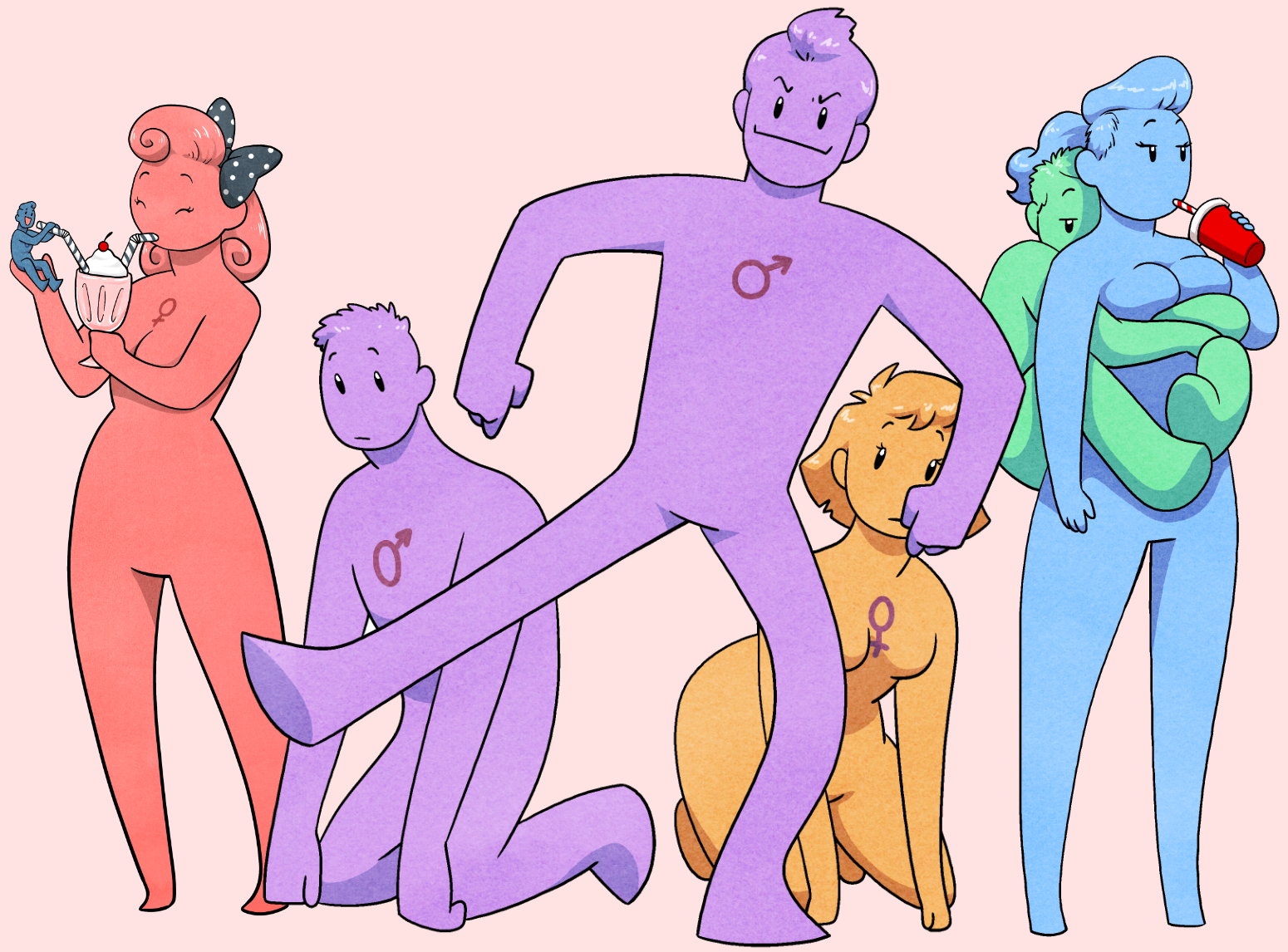
I know gun-fu
The first recorded meetings between Japan and westerners are actually kind of sweet.
The Japanese thought there was some secret to using firearms but the Portuguese were just like "It's easy! Stand straight and close one eye! Couldn't be easier!" but the Japanese still thought it was more complicated than that and assumed the Portuguese were talking philosophy. It took some back and forth to make them understand that it wasn't a difficult discipline to shoot a rifle.
Japan Portugal
21st February 2020
6 years ago #9828711
7
14
That in a nutshell is why general access to guns makes people more rather than less safe. Think about the amount of natural strength and agility, training, practice and experience needed to injure or kill someone with melee weapons if they ALSO have access to those weapons. Most people inclined to come at you with a lance, sword, machete, knife or bat will be fairly adept at using it (mainly because people like that either become adept relatively quickly or become incapable of coming at anyone with anything.) Even if you HAVE lots of training and experience, someone with equal or even slightly less training and experience but greater physical strength and dexterity will retain the overall advantage.
Now think about the amount of innate physical ability and competent practice it takes to injure or kill someone with a gun if they have access to the same guns: Whoever lines up their shot first wins, just that quickly and easily. It really does not matter if you are a 40 kg unathletic person facing down a 125 kg Olympic weightlifter: Shoot straighter faster and your problem ceases to exist. Even if he is a special forces combat veteran; the odds you have better aim than him are admittedly low in that case--unless you are ALSO a special forces combat veteran, in which case we are back to "whoever shoots straighter faster wins." But if you duel him with swords he will probably overpower and kill you (or worse) unless you are MUCH better with your weapon.
Obviously some groups of people should NOT have guns--nor swords, knives or bats; anyone with a proven history of criminality or mental illness, and children too young to have impulse control or recognize the difference between right and wrong or fantasy and reality. Just as obviously, we should mandate everyone with a gun is competent to use, carry, own, store and maintain one, precisely because it is so much easier for ANYONE with a gun to seriously injure or kill someone. If a four-year-old swings a bat at you, you can probably disarm them easily, and probably will not be hurt very badly if you do not; if a four-year-old points a gun at you, your life could instantly end. A clumsy knife wielder is usually dangerous mostly to themselves alone, if only because of limited reach, but a clumsy gun wielder is a mortal threat to anyone within its considerable range. The worst result of a poorly stored and maintained bat is that it cracks and splinters when it hits something; the worst result of a poorly stored and maintained gun is that it could go off when jostled or explode when fired. There are no ancient tales of people speared to death by their own hunting dogs, but there are modern cases of people nearly or ACTUALLY killed when their dog spooked while traveling in a car with a gun, caught the trigger with a paw while scrambling around, and consequently shot them. I have seen two such stories in the news in as many years, without even looking for them (they stuck in my mind because people being shot to death by their own pets makes for a memorable story.) That is not even POSSIBLE when a gun is properly stored, but stupid people doing stupid things with weapons tend to end tragically.
I find it both interesting that so many peaceful Western European nations have some of the worlds highest per capita gun ownership yet lowest murder rates, and frustrating that so few people (at least on the Atlantics other side) realize that. Most people believe the whole continent of Europe a "Gun Free Zone," with the sole difference that the left thinks that a paradise and the right thinks it a killing field. Both sides are embarrassingly in error due to their even more embarrassing shared ignorance.
A final note: I have a number of sharp knives in my kitchen drawer. I also happen to have an elementary school-aged child. What I do NOT have is any significant concern that she will seriously injure or kill herself, any of her friends, my wife or me by taking out one of those knives and playing with it. She will not even use the "grown up" SCISSORS: She does not have access to them, but would not use them even if she did, because she knows they are DANGEROUS for young children, because she in turn knows young children do not know how to use them properly. She certainly does not consider them toys, and if she found something that "looked like" a toy knife or adult pair of scissors she would not blithely assume she could safely play with it. Because I am trying not to raise a moron, and realize that that starts with not being a moron myself. ;)
Now think about the amount of innate physical ability and competent practice it takes to injure or kill someone with a gun if they have access to the same guns: Whoever lines up their shot first wins, just that quickly and easily. It really does not matter if you are a 40 kg unathletic person facing down a 125 kg Olympic weightlifter: Shoot straighter faster and your problem ceases to exist. Even if he is a special forces combat veteran; the odds you have better aim than him are admittedly low in that case--unless you are ALSO a special forces combat veteran, in which case we are back to "whoever shoots straighter faster wins." But if you duel him with swords he will probably overpower and kill you (or worse) unless you are MUCH better with your weapon.
Obviously some groups of people should NOT have guns--nor swords, knives or bats; anyone with a proven history of criminality or mental illness, and children too young to have impulse control or recognize the difference between right and wrong or fantasy and reality. Just as obviously, we should mandate everyone with a gun is competent to use, carry, own, store and maintain one, precisely because it is so much easier for ANYONE with a gun to seriously injure or kill someone. If a four-year-old swings a bat at you, you can probably disarm them easily, and probably will not be hurt very badly if you do not; if a four-year-old points a gun at you, your life could instantly end. A clumsy knife wielder is usually dangerous mostly to themselves alone, if only because of limited reach, but a clumsy gun wielder is a mortal threat to anyone within its considerable range. The worst result of a poorly stored and maintained bat is that it cracks and splinters when it hits something; the worst result of a poorly stored and maintained gun is that it could go off when jostled or explode when fired. There are no ancient tales of people speared to death by their own hunting dogs, but there are modern cases of people nearly or ACTUALLY killed when their dog spooked while traveling in a car with a gun, caught the trigger with a paw while scrambling around, and consequently shot them. I have seen two such stories in the news in as many years, without even looking for them (they stuck in my mind because people being shot to death by their own pets makes for a memorable story.) That is not even POSSIBLE when a gun is properly stored, but stupid people doing stupid things with weapons tend to end tragically.
I find it both interesting that so many peaceful Western European nations have some of the worlds highest per capita gun ownership yet lowest murder rates, and frustrating that so few people (at least on the Atlantics other side) realize that. Most people believe the whole continent of Europe a "Gun Free Zone," with the sole difference that the left thinks that a paradise and the right thinks it a killing field. Both sides are embarrassingly in error due to their even more embarrassing shared ignorance.
A final note: I have a number of sharp knives in my kitchen drawer. I also happen to have an elementary school-aged child. What I do NOT have is any significant concern that she will seriously injure or kill herself, any of her friends, my wife or me by taking out one of those knives and playing with it. She will not even use the "grown up" SCISSORS: She does not have access to them, but would not use them even if she did, because she knows they are DANGEROUS for young children, because she in turn knows young children do not know how to use them properly. She certainly does not consider them toys, and if she found something that "looked like" a toy knife or adult pair of scissors she would not blithely assume she could safely play with it. Because I am trying not to raise a moron, and realize that that starts with not being a moron myself. ;)
6 years ago #9828708
7
1
Fun fact, until the 18th century, firearms were more prevalent in Japanese warfare than in European warfare. Most of what you "know" about Japanese history is a combination of nationalist propaganda and historical fetishization. "Bushido" as a word did not enter the common language until 1899, and was virtually non-existent in literature before then. And that's not even getting in to the swords...
6 years ago #9828781
5
0
And later Japanese warlords/generals took this concept of "ease of use" and ran with it like you wouldn't believe. It took years to teach someone how to fight with a sword, a bow, or on horseback, it only took weeks to train someone to use a matchlock. In fact when Japan finally reunified and decided to invade Korea, over a sixth of the Japanese army was armed with matchlocks.
Ironically the thing it was more difficult to produce large quantities of firearms than it was to train people to use them. Because of course at first the firearms had to be imported from literally the other side of the globe. And then when the Japanese did start building their own matchlocks, the gunsmiths sat on the secret like a jealous dragon guarding its horde. So only a relatively small group of people knew how to actually make the things.
Ironically the thing it was more difficult to produce large quantities of firearms than it was to train people to use them. Because of course at first the firearms had to be imported from literally the other side of the globe. And then when the Japanese did start building their own matchlocks, the gunsmiths sat on the secret like a jealous dragon guarding its horde. So only a relatively small group of people knew how to actually make the things.
6 years ago #9828689
5
1
And yet, to be truly proficient takes training and discipline. I think the Brother Japan could relate to that.
6 years ago #9828720
4
3
It ain't hard to USE a gun, but to use one with SKILL takes practice. When I was in high school (15 years ago...my God I'm old) we had to take shooting lessons. You'd be stunned to see how many kids are totally hopeless with a rifle. 90% of these eighteen year olds didn't know how to fucking aim. Some even got knocked on their asses by the kickback. It's a gun, morons. It has a kickback. It's not like playing Doom. I grew up with a game hunter father and learned to use guns fairly well by age 10, so shooting a stationary, huge target was simple. I'd love to see some of the other students try to hit a rabbit or a squirrel! Hell, I bet they'd even have trouble hitting a big buck.
6 years ago #9828725
3
0
Well, but it was a *foreign thing.* Anything weird and above all FOREIGN just *has* to have hidden secrets that makes it difficult to learn, because if it were obvious and attractive then the local culture would already have it, right? And would have mastered it long, long ago, and then they'd be muffling laughter behind their hands at the Foreign Devils and their Simplistic Foreign Guns. (This holds true for every freakin' culture in the world about every *other* freakin' culture in the world, from Anglo-Saxon to Zulu; it just does.)
BTW, I absolutely love Ancient Japan's and Ancient Portugal's outfits. Very nice.
BTW, I absolutely love Ancient Japan's and Ancient Portugal's outfits. Very nice.
6 years ago #9828717
3
0
I actually really like that outfit design for Japan - it should be used more often
Add comment: Please Sign in or create an accout to comment.



 Support the comic on
Support the comic on 































31
Bayonets, making guns backwards compatible.